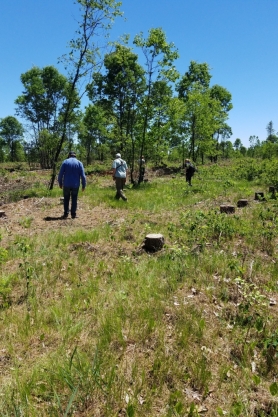Habitat Conservation Plan
Karner blue butterfly
HCP Partnership
The HCP currently has over 50 partners across the state. HCP partners agree to follow specific protocols to avoid and minimize impacts to Karners during the course of their work. In return, the HCP extends permit coverage allowing them to conduct activities that may inadvertently "take" (harass, harm or kill) the federally endangered Karner blue butterfly. The level of take under Wisconsin’s HCP does not threaten the long-term survival and recovery of Karners in the state. The long-term viability of Karner blue butterfly populations depends on habitat disturbance. Without periodic disturbance, natural woody succession shades out wild lupine and nectar plants and can passively eliminate Karner blue butterfly populations. Fortunately, many HCP partners and management activities provide the necessary habitat disturbances to maintain Karner habitat on the landscape. Although HCP partner management activities may result in some Karner mortality, the absence of short-term disturbance would result in greater long-term losses of Karners and their habitat.
Should I join the HCP Partnership?
This simple questionnaire will help you determine your requirements, participation level and opportunities for Karner blue conservation. You can view all the partnership levels here.
Step 1 - determine permit need
Do I need to apply for incidental take permit coverage or am I automatically covered?
- Do you have Karner blue butterfly habitat on your land?
- If no, no further action is required
- If yes, go to question #2
- Does your land management involve:
- A - Right-of-way or corridor development or maintenance?
- B - Forestry on more than 1,000 acres?
- C - Permanent take of Karner blue habitat? Note: Permanent take activities include but are not limited to the construction of roadways, parking lots, buildings, residential subdivisions and condominiums, or other developments that preclude Karner blue butterfly occupation for a minimum of five years. Construction of homes and associated structures used by the owner are exempted.
If no, you are automatically covered and may participate in Karner blue conservation voluntarily. Check with the HCP coordinator if you are unsure of how the plan defines your land management activity.
If yes to A, B or C, you must apply for incidental take permit coverage. Failure to do so may result in a violation of the U.S. Endangered Species Act. To learn more about receiving incidental take permit coverage through the statewide habitat conservation plan, go to Step #2.
Step 2 - determine participation status
If I choose to apply for incidental take or permanent take permit coverage under Wisconsin’s Habitat Conservation Plan, which category (full, limited or one-time permittee) best fits my needs?
- Which of the following three categories best describe your land management activities:
- A - Ongoing harvest and regrowth of timber resulting in incidental and possibly permanent take (e.g., commercial forestry).
- B - One-time development or construction resulting in permanent take (e.g., subdivision construction).
- C - Right-of-way and/or corridor maintenance and construction (e.g., utility, railroad and highway rights-of-way management).
If A, you should apply for full partner status. This status requires the broadest participation and affords the broadest coverage. Contact the HCP coordinator for application procedures.
If B, you should apply as a one-time permittee. This non-partner status requires compensatory mitigation. Contact the HCP coordinator for application procedures.
If C, go to question #2.
- As a right-of-way or corridor manager, will your activities result in ongoing incidental take (e.g., maintenance) AND possible permanent take (resulting from construction)?
If yes, you should apply for partner status. Contact the HCP coordinator for application procedures.
If no, go to question #3. - As a right-of-way or corridor manager, what will your activities include:
- A - Ongoing incidental take only (e.g., maintenance), or
- B - Permanent take only (e.g., construction)?
If A, you should apply for limited partner status. This requires a simple inclusion process and compliance with best management practices. Contact the HCP coordinator for application procedures.
If B, you should apply as a one-time permittee. This non-partner status requires compensatory mitigation. Contact the HCP coordinator for application procedures.


